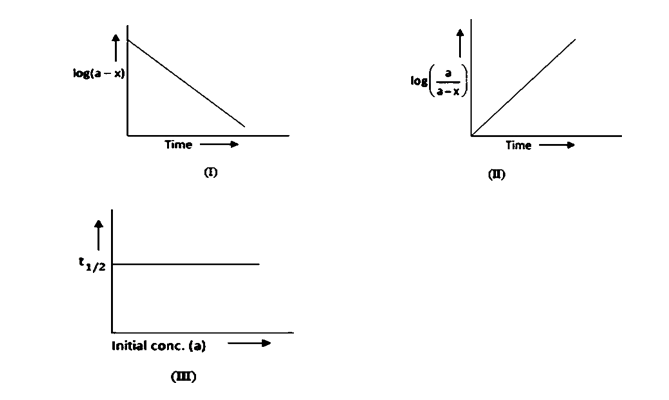Which of the following is correct for zero and first order reactions respectively, where 'a' is initial concentration of the reactant ?
t1/2∝a,t1/2∝1a2
t1/2∝a,t1/2∝1a
t1/2∝a,t1/2∝a0
t1/2∝a0,t1/2∝a
The correct Answer is:C
To solve the problem regarding the relationship between half-life periods and initial concentration for zero and first order reactions, we will follow these steps:
Step 1: Understand Half-Life
The half-life (t_half) of a reaction is the time required for the concentration of a reactant to decrease to half of its initial concentration.
Step 2: Zero Order Reaction
For a zero-order reaction, the half-life is given by the formula:
t1/2=(A)02k
Where:
- (A)0 is the initial concentration of the reactant.
- k is the rate constant.
From this formula, we can see that the half-life is directly proportional to the initial concentration (A)0:
t1/2∝(A)0
Step 3: First Order Reaction
For a first-order reaction, the half-life is given by the formula:
t1/2=0.693k
In this case, the half-life is independent of the initial concentration. Therefore, we can express it as:
t1/2∝(A)00
This indicates that the half-life does not change with varying initial concentrations.
Step 4: Combine Results
From the above steps, we can summarize:
- For zero-order reactions: t1/2∝(A)10
- For first-order reactions: t1/2∝(A)00
Step 5: Identify the Correct Option
Now, we need to match these results with the options given in the question. The correct expressions for zero and first order reactions respectively are:
- Zero order: (A)10
- First order: (A)00
Thus, the correct answer is the option that states (A)10 for zero order and (A)00 for first order.
Conclusion
The correct option is the one that states:
- For zero order: (A)10
- For first order: (A)00
The half-life (t_half) of a reaction is the time required for the concentration of a reactant to decrease to half of its initial concentration.
For a zero-order reaction, the half-life is given by the formula:
t1/2=(A)02k
Where:
- (A)0 is the initial concentration of the reactant.
- k is the rate constant.
t1/2∝(A)0
For a first-order reaction, the half-life is given by the formula:
t1/2=0.693k
In this case, the half-life is independent of the initial concentration. Therefore, we can express it as:
t1/2∝(A)00
This indicates that the half-life does not change with varying initial concentrations.
From the above steps, we can summarize:
- For zero-order reactions: t1/2∝(A)10
- For first-order reactions: t1/2∝(A)00
Now, we need to match these results with the options given in the question. The correct expressions for zero and first order reactions respectively are:
- Zero order: (A)10
- First order: (A)00
The correct option is the one that states:
- For zero order: (A)10
- For first order: (A)00
Topper's Solved these Questions
Similar Questions
Which of the following is/are correct for the first order reaction ? (a is initial concentration of reactant, x is concentration of the reactant reacted and t is time)

View SolutionWhich of the followoing expression is correct for first order reaction ? (CO) refers to initial concentration of reactant.
View Solution
Knowledge Check
Which of the following expressions is correct for zero order respectively [Where a is initial concentration]?
At1/2∝a,t1/2∝1aBt1/2∝a,t1/2∝a∘Ct1/2∝a∘,t1/2∝aDt1/2∝a,t1/2∝1a2Which of the following expressions is correct for first order reaction? (a0 refers to initial concentration of reactant)
At1/2∝a00Bt1/2∝a−20Ct1/2∝a−10Dt1/2∝a0Which of the following expresison is correct for first order reaction (c0 refers to initial concentration of reactant)
At1/2∝c0Bt1/2∝c−10Ct1/2∝c−20Dt1/2∝c00
Which of the following expression is correct for first order reaction? Ao refers to initial concentration of reactant
View SolutionWhich of the following graph is correct for a first order reaction of the type R→P?
Where [] represents concentration.
View SolutionFor a first order reaction, if ‘a’ is the initial concentration of reactant, then the half life time is
View SolutionThe rate constant for a first order reaction is equal to the initial rate of reaction when the initial concentration of the reactant is
View SolutionWhich of the following is correct representation of the variation of half - life with initial concentration of a zero order reaction ?
View Solution
